Aukey PA-U32 USB Power Adapter Tear-Down
Back To Compact
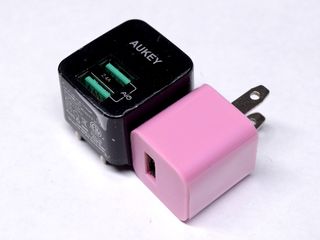
After our first look at compact adapters in the Apple 5W Adapter Knock-offs: The Colorful A1265 Tear-Down, it's time to test something a little more reputable and hopefully see how much safety can be crammed into a compact form factor designed correctly.
Stepping in as the first ~$10 entry is Aukey’s PA-U32, with its foldable prong design to reduce travel volume and poking hazard, two USB ports to plug devices into, and a claimed output of up to 2.4A.
MORE: AmazonBasics ABHT1208TC Tear-Down
MORE: APC BN650M1-CA UPS Tear-Down
MORE: How (And Why) We Test USB Power Adapters
Weight Classes

The first thing that struck me when I picked up the PA-U32 was how much heavier it seemed than our previous contender, which I promptly confirmed with a digital scale. At 33g (versus 16g), there is clearly more meat inside. We'd expect that from an adapter offering more than twice the nominal current output rating.
Body-to-body, the PA-U32 is also about 80% bigger than the fake A1265, including the space taken by the folded prongs. Subtracting their width from the U32’s height (giving us an approximate size without the folding mechanism) reduces the volume difference to 40%.
Stay on the Cutting Edge
Join the experts who read Tom's Hardware for the inside track on enthusiast PC tech news — and have for over 25 years. We'll send breaking news and in-depth reviews of CPUs, GPUs, AI, maker hardware and more straight to your inbox.
MORE: AmazonBasics ABHT1208TC Tear-Down
MORE: APC BN650M1-CA UPS Tear-Down
MORE: How (And Why) We Test USB Power Adapters
Box
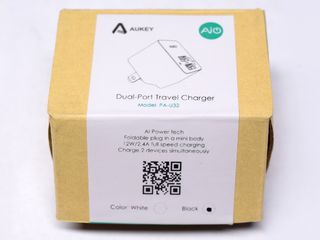
The PA-U32’s packaging consists of one large cardboard sheet folded into a generic box with a label slapped on top to seal its contents. Since the box is about twice the size of the adapter, an additional piece of folded cardboard is used to cradle the adapter and prevent it from rattling around. There are no accessories, manuals, or other bundled items included.
MORE: AmazonBasics ABHT1208TC Tear-Down
MORE: APC BN650M1-CA UPS Tear-Down
MORE: How (And Why) We Test USB Power Adapters
Bottom

On the outlet-facing side, we find two prongs recessed flush with the adapter (apart from a ridge on the edge to facilitate flipping them to their working position). The folding mechanism provides a decent amount of holding force in both positions, so accidental flips should be uncommon. What does that random AQH31 stand for? Online searching failed to yield clues. My best guess would be an internal part number for the NA-style plug end.
As with any glossy black surface, keeping it free from dust and fingerprints proves impossible.
MORE: AmazonBasics ABHT1208TC Tear-Down
MORE: CyberPower EC350G Tear-Down
MORE: How (And Why) We Test USB Power Adapters
Online Oopsie
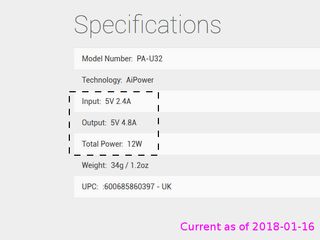
Much of the time, I tear through units without looking at their online product pages. But when I checked the one for Aukey’s PA-U32, I found some obvious copy/pasting issues. While the specs correctly state 12W, its 2.4A/5V output gets listed as the input. Moreover, the output gets listed at twice what the adapter is supposed to be rated for. There is no way a 12W adapter can output 4.8A at 5V.
I’m scratching my head about how these silly mistakes got through uncorrected and remained live for so long. Because I notified Aukey, they may have been corrected by the time you read this.
MORE: AmazonBasics ABHT1208TC Tear-Down
MORE: CyberPower EC350G Tear-Down
MORE: How (And Why) We Test USB Power Adapters
It’s Going To Be One Of Those Days

Looking at the only seam on the whole unit, and judging by the lack of movement when squeezing/pulling in various directions, this must be another one of those welded-shut affairs requiring the careful application of crushing force to crack open without destroying its internals.
Along the whole perimeter, this is the most promising area where the side wall bows out the most from the bottom cap.
MORE: AmazonBasics ABHT1208TC Tear-Down
MORE: CyberPower EC350G Tear-Down
MORE: How (And Why) We Test USB Power Adapters
Label
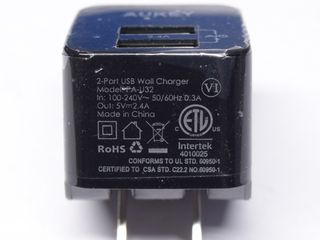
The label area contains identifying information, along with electrical specifications and applicable certifications. We get an ETL mark for compliance with CSA 22.2 and UL 60950-1, which are baseline safety against electric shock, heat injury, mechanical integrity, and fire hazard.
One thing that bothers me about ETL marks is that the “ETL-Listed” directory does not appear to be searchable by file number. At least searching for the model does return a sensible result telling us that this adapter is manufactured by Dongguan Oriental Hero Electrical Factory and distributed under the Aukey, BC Master, H, OPPC, PPC, and "blank" brands.
Also of interest is the Level-VI logo that promises modern-day efficiency.
MORE: AmazonBasics ABHT1208TC Tear-Down
MORE: CyberPower EC350G Tear-Down
MORE: How (And Why) We Test USB Power Adapters
Front

The adapter’s face features two “AiO” USB ports capable of providing a combined maximum of 2.4A, Aukey’s brand, and a small white power indicator LED to the left of those ports (though it's hard to see under the plastic film).
MORE: AmazonBasics ABHT1208TC Tear-Down
MORE: CyberPower EC350G Tear-Down
MORE: How (And Why) We Test USB Power Adapters
Molding Trouble
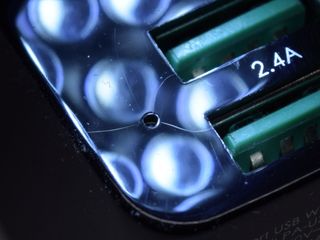
Upon removing the plastic film, I noticed hairline cracks radiating from the tiny LED hole. I’ll hazard a guess that fast, uneven cooling of the thin plastic shell caused these. The area still feels solid, which means these are only surface cracks. For now.
MORE: AmazonBasics ABHT1208TC Tear-Down
MORE: CyberPower EC350G Tear-Down
MORE: How (And Why) We Test USB Power Adapters
Goodbye Surface Finish

It's time to break out the mini-vise, work that seam until one side pops apart, stuff it with shims, and pry until the rest breaks off.
MORE: AmazonBasics ABHT1208TC Tear-Down
MORE: CyberPower EC350G Tear-Down
MORE: How (And Why) We Test USB Power Adapters
Uncapped
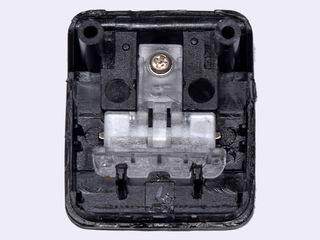
Many minutes of squeezing and prying later, the plug-bearing cap came off with no wires attached. This adapter definitely won’t fall apart from normal use or minor accidents.
Instead of wires going to the pokey bits, the two prongs have a perpendicular pin slightly protruding from their respective sides making contact with fingers extending from the adapter’s AC board. To assist with assembly, two plastic posts near the top help support and locate the rest of the adapter’s guts on top of the cap.
MORE: AmazonBasics ABHT1208TC Tear-Down
-
d.schrei3er About the "cracks" around the LED hole: three flowsthey are "knit lines" caused by the flow of plastic into the mold. Its pretty obvious that the plastic converged at the LED hole from 3 fronts: over, under, and in between the two USB holes. By the time the plastic reaches that location it has cooled enough (at least at the surface) that the 3 flows are not hot enough to fully weld. You comment that it seems solid, which it most likely is, and the obvious knit lines may merely be a cosmetic surface defect caused by minimising mold temperature, pressure, and cycle time past the bare minimum. I.e.: there's a reason this device only costs $9.99.Reply -
mikewinddale Thanks for doing these teardowns. I own two Aukey products: a 20,000 mAh battery pack and a Quickcharge charger. This teardown gives me some extra piece of mind.Reply -
Farrwalker This type of article is interesting to me. So may USB chargers out there and so little objective information.Reply
I recently bought three of Quick Charge 3.0,Onlier 30W Qualcomm USB Wall Charger 3-Port USB Fast Travel Adapter.
It is supposed to have the following features:
Quick Charge 3.0
4x faster than conventional charging. Charge a compatible mobile phone up to 80% in 35 minutes.
Charging Quicker, Using Safer
Protect your devices against excessive current, overheating, and overcharging; avoid any security issues happening.
Qualcomm Quick Charger 3.0 Specification
Input:100v-240VAC 50/60HZ.
Output :
1:DC3.6v-6.5v/3A Dc6.5v-9v/2A Dc9v-12v/1.5A
2:DC5V2.4A max
3:DC5v 2.4A max -
Xajel I have a very good experience with AUKey in their cables, I use Type-C ( with QC 3.0 phone and charger ) and Lightening and both are awesome.. I had one charger before which was working flawlessly with all my devices.. but I lost it somewhere...Reply
For me, AUKey, Tronsmart, Choetech & UGreen are good Chinese brands that worked hard to distinguish themselfs from other cheap makers... -
Lutfij A very nice read! I'll relay the info to my little brother who is an avid user of smart phones and tends to go through USB chargers like the wind :PReply -
Daniel Sauvageau Reply20664608 said:Nice. Could you do the same for Ugreen 17W 3.4A?20665135 said:Yeah ! me too, Ugreen. I have the CD132 dual USB 30W Quick Charge 3.0 but any will do.
Glad you found it useful. I'll put Ugreen on my watch list for when I run low on my current stock One problem with buying stuff for future articles so far in advance (and without even knowing beforehand if the topic is going to be a hit or a miss to justify having so many samples ready to go) is that much of it may be gone from the market by the time I get around to it.20666135 said:Thanks for doing these teardowns. I own two Aukey products: a 20,000 mAh battery pack and a Quickcharge charger. This teardown gives me some extra piece of mind.
That sounds plausible. I don't buy the cost-cutting argument though: you can change where flows meet by adding an extra injection port or widening an existing port, adding/widening/closing vents, making runners slightly deeper, etc. all of which adding very little cost. If $2 adapters can achieve visually defect-free glossy finish, a $10 one should easily be able do the same. Granted, most of the cheapest adapters have a simpler shell with only one USB-A hole in it which makes it more difficult to get it wrong. With only one unit in my inventory though, the surface defect could be an exception rather than the norm.20665605 said:About the "cracks" around the LED hole: three flowsthey are "knit lines" caused by the flow of plastic into the mold.
Chrome? I had issues previewing the article on it too, had to read it with Edge.20667527 said:No images are showing.
Most Popular






